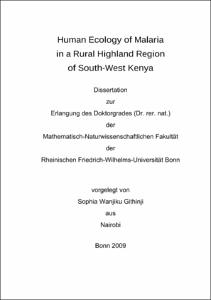Human Ecology of Malaria in a Rural Highland Region of South-West Kenya

Human Ecology of Malaria in a Rural Highland Region of South-West Kenya

| dc.contributor.advisor | Kistemann, Thomas | |
| dc.contributor.author | Githinji, Sophia Wanjiku | |
| dc.date.accessioned | 2020-04-14T05:05:03Z | |
| dc.date.available | 2020-04-14T05:05:03Z | |
| dc.date.issued | 22.12.2009 | |
| dc.identifier.uri | https://hdl.handle.net/20.500.11811/4174 | |
| dc.description.abstract | Malaria kills nearly a million people a year, uses almost half of the clinical services in Africa, and reduces economic growth by up to 1%. The immense and persistent burden of malaria makes its control one of the most important challenges in global public health. The present study examined the associations of malaria incidences with micro-ecological, socio-demographic and behavioural aspects in a rural epidemic zone in south-west Kenya. A case-control epidemiological study design was applied. Malaria patients seeking treatment at a rural health care facility were randomly sampled during a peak transmission period between May and July 2007. Each case was individually matched with a control of the same sex and approximately the same age, drawn from patients suffering from diseases of the respiratory system. In total, 342 cases and 328 controls were sampled. A standardised questionnaire investigating the social, demographic and behavioural aspects related to malaria at the household level was administered. A spot check of factors which could favour mosquito breeding and their contact with human beings was done in and around the survey homesteads. The homesteads were geo-positioned with a hand held global positioning system and straight line distances from the study households to possible risk areas measured. Statistical analyses were done with conditional logistic regression using STATA. Spatial analysis was done with SaTscanTM and ArcGIS. Location of houses on flat swampy areas (mOR 1.81, p-value 0.03), staying outdoors at night (mOR 1.94, p-value 0.03); presence of oxen in the compound (mOR 1.53, p-value 0.03); sleeping in houses with open eaves (mOR 1.45, p-value 0.03) and family size greater than four people (mOR 1.44, p-value 0.04) were associated with increased risk of malaria while sufficient food supplies (mOR 0.60, p-value 0.003) and keeping medicine at home (mOR 0.58, p-value 0.006) were associated with reduced risk of the disease. These findings point to the need for holistic approaches that draw connections between behavioural, socio-economic and micro-ecological factors in malaria control. | en |
| dc.language.iso | eng | |
| dc.rights | In Copyright | |
| dc.rights.uri | http://rightsstatements.org/vocab/InC/1.0/ | |
| dc.subject | Malaria | |
| dc.subject | Einflussfaktoren | |
| dc.subject | mikro-ökologisches Risiko | |
| dc.subject | sozioökonomisch Faktoren | |
| dc.subject | Kenia | |
| dc.subject | influencing factors | |
| dc.subject | microecological risk | |
| dc.subject | socio-economic factors | |
| dc.subject.ddc | 610 Medizin, Gesundheit | |
| dc.subject.ddc | 630 Landwirtschaft, Veterinärmedizin | |
| dc.title | Human Ecology of Malaria in a Rural Highland Region of South-West Kenya | |
| dc.type | Dissertation oder Habilitation | |
| dc.publisher.name | Universitäts- und Landesbibliothek Bonn | |
| dc.publisher.location | Bonn | |
| dc.rights.accessRights | openAccess | |
| dc.identifier.urn | https://nbn-resolving.org/urn:nbn:de:hbz:5N-19749 | |
| ulbbn.pubtype | Erstveröffentlichung | |
| ulbbnediss.affiliation.name | Rheinische Friedrich-Wilhelms-Universität Bonn | |
| ulbbnediss.affiliation.location | Bonn | |
| ulbbnediss.thesis.level | Dissertation | |
| ulbbnediss.dissID | 1974 | |
| ulbbnediss.date.accepted | 30.11.2009 | |
| ulbbnediss.fakultaet | Mathematisch-Naturwissenschaftliche Fakultät | |
| dc.contributor.coReferee | Vlek, Paul L. G. |
Files in this item
This item appears in the following Collection(s)
-
E-Dissertationen (4465)




